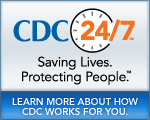MMWR
Morbidity and Mortality Weekly Report
MMWR News Synopsis for August 21, 2008
- Nonfatal, Unintentional, Nona€“Fire-Related Carbon Monoxide Exposures a€” United States, 2004a€“2006
- Update: Measles a€” United States, Januarya€“July 2008
- West Nile Virus Update a€” United States, 2008
There will be an MMWR telebriefing scheduled for:
August 21, 2008 at 12 p.m. ET.
Nonfatal, Unintentional, Nona€“Fire-Related Carbon Monoxide Exposures
PRESS CONTACT: Division of Media Relations
(404) 639-3286
UNFR CO exposure is a leading cause of poisoning in the United States that is most likely to occur at home and is preventable by taking simple precautionary steps such as maintaining home heating systems and installing CO detectors. Carbon Monoxide (CO) is a colorless, odorless, and nonirritating gas. Sources of CO include: combustion devices such as boilers and furnaces, motor vehicle exhaust, generators and other gasoline or diesel-powered engines, gas space heaters, woodstoves, fireplaces, and gas stoves. Health effects of CO exposure can range from non-specific flu-like symptoms to long-term neurological effects, coma, and death. Unintentional, non-fire-related (UNFR) CO exposure is a leading cause of poisoning in the United States resulting in approximately 450 deaths annually. During 2004a€“2006, an estimated 20,636 emergency department visits were reported each year due to UNFR CO exposures. Most (73 percent) of these exposures occurred at home; 41 percent occurred during the winter months (Decembera€“February). Prevention efforts targeting residential and seasonal CO exposures can substantially reduce CO-related morbidity.
Update: Measles
PRESS CONTACT: Division of Media Relations
(404) 639-3286
The 2008 upsurge in U.S. measles cases serves as a reminder that measles can still occur in this country from imported cases. These cases and outbreaks result primarily from failure to vaccinate, many because of philosophical or religious belief exemption. Unvaccinated persons are at risk for acquiring measles themselves and, in turn, for transmitting it to others, including children too young to be vaccinated. Measles is highly contagious and can result in serious complications and death. Due to a successful measles vaccination program, measles elimination (interruption of endemic measles transmission) was declared in the United States in 2000. However, every year, more than 20 million measles cases occur worldwide, and importations of measles into the U.S. will continue. From January 1 through July 31, 2008, the Centers for Disease Control and Prevention received 131 reports of confirmed measles casesa€”the highest number reported for the same time period since 1996. A substantial proportion of these cases occurred among U.S. residents who were unvaccinated because of their own or their parentsa€? personal beliefs. The increase in measles cases this year is not a result of increased measles importations, which have occurred in numbers similar to those in previous years. Instead, the increase in U.S. measles cases is due to increased spread of disease after importation, particularly within communities with large numbers of unvaccinated persons. Increases in the proportion of persons declining vaccination for themselves or their children could result in large-scale outbreaks in the U.S., as has occurred in other countries, such as the United Kingdom, Switzerland, and Italy.
West Nile Virus Update
PPRESS CONTACT: Division of Media Relations
(404) 639-3286
No summary available.
####
- Page last reviewed: August 21, 2008
- Page last updated: August 21, 2008
- Content source: Office of Enterprise Communication
- Notice: Links to non-governmental sites do not necessarily represent the views of the CDC.
View Press Releases in
Get e-mail updates
To receive e-mail updates about this page, enter your
e-mail address:
Contact Us:
- Centers for Disease Control and Prevention
1600 Clifton Rd
Atlanta, GA 30333 - 800-CDC-INFO
(800-232-4636)
TTY: (888) 232-6348 - Contact CDC-INFO


